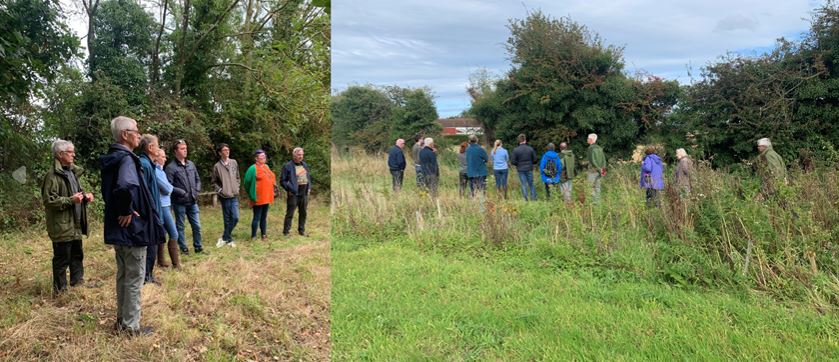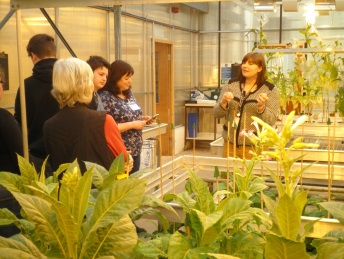Reports
Norfolk mini safari
24 September 2023
The warm afternoon of Sunday 24th, saw thirteen (a lucky number) members and fellows of the Royal Society of Biology, learn about the work of The Felbeck Trust. They initially met at 2pm at Halsey House in Cromer, where a 'spinoff' from the Trust, Cromer Green Spaces, is helping the British Legion manage some of its lawns more efficiently as wildflower meadows, to the benefit of both biodiversity and residents' wellbeing.
This was one the the Society's East Anglian branch meetings, and people had come from as far away as St Ives and Thetford. The group was a mixture of retirees, students, teachers, university researchers and laboratory scientists. They all enjoyed the simple explanations provided by our excellent Chairman of what we are trying to do - conserve the ordinary biodiversity before it becomes rare - and how we are doing that.
A walk around West Beckham Old Allotments, with Trevor explaining the principles behind the meadows, hedgerows and thickets, together with supplementary feeding for turtle doves, was followed by tea and coffee provided by Peter and Val. Then the Susted group of reserves, with just enough cars for the two little car parks, before people went home from there.
Some of the participants are involved in practical conservation land management through their own Parish Councils, all were very impressed with the visions for the sites and the volunteer effort needed to reach them. One comment encapsulates the day as well as the Trust - "The Felbeck Trust members are clearly passionate and committed about the work that they are doing. It is inspirational to see what can be done in relatively small spaces scattered among the urban and rural sprawl and managed agriculture to provide havens for the natural flora and fauna.
Professor David Harper
Water Under the Microscope: An Introduction to the Microbiology Behind Water and Sewage
13 May 2022
This May, the Eastern Area of the Institute of Water and the East Anglia Branch of the Royal Society of Biology collaborated to form the latest event in all things water and microbiology, “Water under the microscope: An introduction to the microbiology behind water and sewage”.
Facilitated by Lucy Hird, MIWater (Change Manager, Anglian Water), this event delved into the depths of the science behind the water industry.
A thorough grounding of microorganisms was delivered by Dr Natalie Lamb, RSci MIWater MRSB (National Water Industry Account Manager, QCL), which demystified the names of these organisms, illustrated the differences between different species, exposed what microorganisms can look like and provided top tips to sound more like a microbiologist.
Dr Nicola Johnston, CSci MIWater MRSPH (Training and Development Scientist, Anglian Water) discussed the history of water quality, the importance of deactivating these microorganisms for human health and how the water industry is working to achieve the provision of wholesome drinking water.
While Alexandra Webb, MSc (North American Rep Manager, SENTRY) discussed how microorganisms are vital in wastewater systems for the adequate breakdown of sewage within wastewater treatment plants and how microbial monitoring instrumentation, such as SENTRY, can be used to monitor compliance and prevent pollution.
Although this was not a small event, with over 180 signed up, we left with more than a small appreciation of this tiny hidden world around us. Thank you so much for all our speakers and attendees for making the event such a hit!
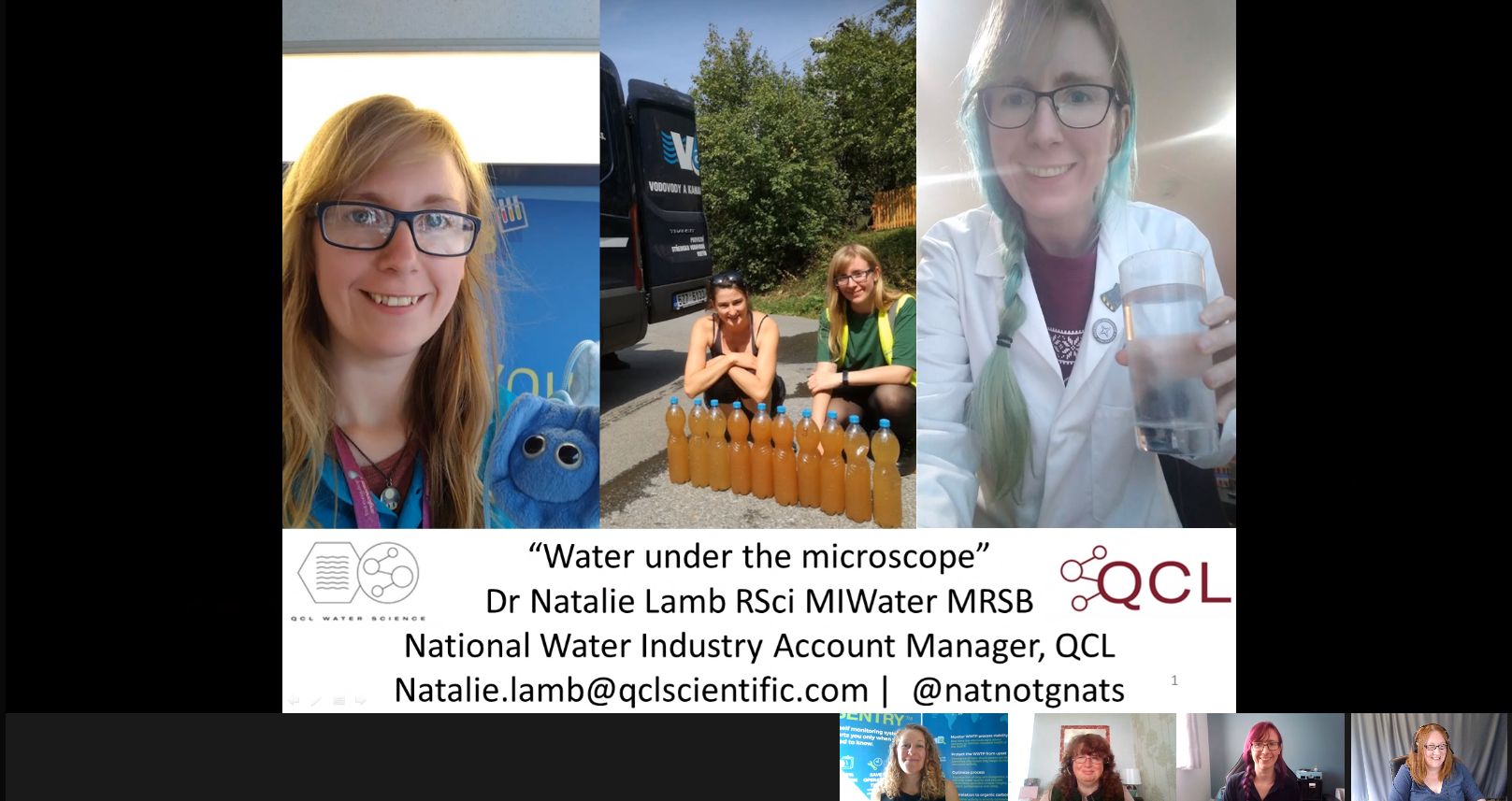
Natalie Lamb RSci MRSB
What Has Biophysics Done for Us?
03 May 2022
Did you know that how you recognise a hug from a loved one could help us in space travel? Or that the wings of moths absorb sound to avoid detection from bats - and that this could help us provide thin, soundproof wallpaper?
These are just some of the things the East Anglia branch learned in our thorough grounding of the exciting world of the biophysics surrounding us, in our most recent “What has biophysics done for us?” event. The event was designed to celebrate and raise awareness of biophysics, the scientific discipline in which the theories and methods of physics (and other sciences) are applied to understand how biological systems work.
We welcomed Dr Tharin Blumenschein (Associate Professor and Head of School for Natural Sciences at the University of East Anglia), who, in her capacity of the British Biophysical Society Secretary, spoke with us about the British Biophysical Society (BBS), which is a member organisation of the Royal Society of Biology. The BBS reaches around 500 members, organising and sponsoring specialist events, major biennial meetings, newsgroups, travel bursaries and awards, to promote biophysics in the UK.
We were then joined by our keynote speaker, Professor Anthony Watts (former FSoB), Leverhulme Emeritus Fellow at Oxford University and President-Elect of the International Union of Pure and Applied Biophysics (IUPAB). Professor Watts described the history of biophysics, discussed some of the contributions it has made to our everyday lives and contemplated on the new and emerging outcomes from a quantitative understanding of biology.
For those wanting to know more about the topic, the British Biophysical Society have their next biennial meeting “From Molecular Machines to Materials” 29 June-1st July in Galway this year. For more details please visit the event page.
Natalie Lamb RSci MRSB
The Botany Behind Christmas
20 December 2021
The East Anglia branch celebrated the Christmas season with a fascinating series of lectures discussing the science behind the plants rooted in our winter-time traditions.
You might want to avoid putting your Christmas tree up in the kitchen; fruit such as bananas can release ethylene which can prompt the needles to fall out earlier.
Think your cranberries are getting sweeter? They might well be! Modern molecular and genetic techniques have resulted in variety changes over the last century, including higher yields, sweeter tastes, firmer berries, an early red colour and higher antioxidants.
Did you know that the kissing under the mistletoe tradition actually resulted from a distillation of ancient tradition, including Norse and Druidic myths, and not from that rom-com that you watched as a child?
These are just some of the many things we learnt at our East Anglia Christmas event! Over 50 people joined in to hear from three expert speakers: Professor Rajasekaran Lada, our Christmas tree expert speaking about “Science for Society: a journey with Christmas trees”; Professor Jed Colquhoun, our cranberry expert on “From foraged harvest to refined innovation: The story of the American cranberry”; and Jonathan Briggs, our mistletoe expert on “British and Irish mistletoe issues this winter”.
All of our speaker’s presentations can be found on the RSB YouTube channel.
Thank you so much to everyone who came along and also to our excellent experts, who really made the event quite the Christmas treat!
Natalie Lamb RSci MRSB
East Anglia branch Annual General Meeting and virtual networking
12 October 2021
I wanted to extend a massive thank you to all our members for coming along to our AGM. It was wonderful to see you all. I realise things have looked a little differently recently but I’m so grateful to you all for supporting our branch, familiar faces as well as new.
Congratulations were given to Dr Penny Maplestone FRSB for starting the role of Secretary. Well done Penny and thank you so much for the hard work you have already done for us as a branch.
We are a close-knit informal committee who are always open to new people joining us. Please feel free to get in touch with myself, Natalie Lamb, Chair of the East Anglia branch at eastanglia@rsb.org.uk if you are interested.
Over the next year we have a flexible programme planned of events to be taken online or in person as needs be. While we love the accessibility of online events, we cannot wait to also add a few in person visits to the mix. Watch this space!
You can find more information and our meeting notes online at www.rsb.org.uk/EastAnglia
While our AGM was a great success, we never did manage to escape our virtual escape room!
Natalie Lamb RSci MRSB
A little bit of science and more than a little bit of chocolate
30 September 2021
The East Anglia Branch had a tantalising Tasting Adventure with Hotel Chocolat at their Virtual Chocolate Tasting Experience.
Amy Horwood, our Master Chocolate Expert, taught us about the world of chocolate. All the way from how chocolate is made, from the cacao tree (Theobroma Cacao, or aptly named "food of the gods") to bar. Amy also showed guests the quality differences between other leading chocolate manufacturers (no brand names mentioned, of course!).
Amy did an excellent job of leading us through our hour of chocolate escapism. I have to say, I personally struggled with the tasting part of the session. I kept gobbling up the chocolates, forgetting to taste them! I even enjoyed the white chocolate, something I don’t normally eat. Maybe it’s because, as Amy told us, the quality of white chocolate can be compromised if it contains a low percentage of cocoa bean products. But Hotel Chocolat goes above and beyond the EU standard of 20% cocoa butter to have a minimum of 36%.
One to check the wrapper on in future! Chocolate ingredients should always lead with Cocoa, contain milk powder, sugar, cocoa butter, and an emulsifier, along with any natural flavourings like peppermint oil or passion fruit juice. If there are any other oils, like vegetable or palm oil, try another brand.
In either case, checking the wrappers of all these chocolate bars is a good excuse to eat some more Cocoa. It’s for the sake of science, after all!
All in all, this event certainly lived up to its name, providing a little bit of science and, if possible, far, far more than a little bit of chocolate!
Natalie Lamb RSci MRSB
Connecting and networking – online
10 June 2021
Nicholas Duggan from Viadynamics, a leading innovating agency, provided a comprehensive learning experience, centred around innovation, connecting and networking, despite the virtual environment we now find ourselves in.
Really drawing from this digital environment, this East Anglia branch event went far beyond the reaches of the East of the UK with attendees from as far as India and Hong Kong.
Nicholas walked us through the translation of scientific discovery into the world of business, paving the way with his experience as the founder of Cellesce, a biotechnology start-up based in Cardiff.
Questions posed from the training included: How to pitch to businesses? What is it like in businesses? What type of innovation are you trying to do? What is the innovation approach of the companies? Where are you trying to fit into this? Nicholas helped us by posing the question are you a ‘Just Eat’, looking to reinvent how the food industry works, or are you a local heritage food looking to expand, like Henderson’s’ Relish? Really knowing yourself, your niche and where you want to be going is the key to help you get there.
One reoccurring theme from the event was the importance of relationships. As in your personal life, business relationships are all about building trust. If you do favours for people, they will build a relationship with you. If you build relationships, you will forge links and eventually get accepted into people’s ecosystems. And all of this is still 100% possible online.
If you missed this excellent CPD-approved training session, you can catch up at any time by watching the full event on the RSB YouTube: https://youtu.be/SLSyP8cREyI
Natalie Lamb RSci MRSB
Enterprising Biology
23 July 2020
The idea for this event was to link businesses on Norwich Research Park with scientists and students. It was organised by the Norwich Research Park and the UEA Employability Team, and chaired by Dr Liliya Serazetdinova FRSB, from the Earlham Institute. The event took place virtually with excellent support from the RSB events team! It was attended by 31 people.
The event started with David Parfrey, Executive Chair of Anglia Innovation Partnership LLP Board, who gave an introduction to the Norwich Research Park vision to change lives and re-think society through pioneering research and innovation.
Dr Orr Yarkoni, CEO of Colorifix Ltd, explained how their company helps to reduce environmental impacts of textile dyeing, one of the most polluting industrial processes, using over 70 highly toxic chemicals and responsible for 20% of global industrial water pollution. The company developed a new dying technology that utilises synthetic biology to borrow colours from nature and transfer them directly into textiles. Colorifix developed the process for a range of colours and proved it at scale.

Dr Ross Overman, Principal Scientist Process Development at the Leaf Expression Systems Ltd, shared the history of the company, from the development of the Hypertrans® technology by Professor George Lomonossoff at the John Innes Centre (JIC), and Frank Sainsbury, then a PhD student at JIC, in 2007, to a formation of a Joint Venture between JIC, Plant Bioscience Ltd, and Biotechnology and Biological Sciences Research Council (now part of the UKRI) in 2015. Ross showed how the Hypertrans® technology helps to reduce costs in development and manufacture of therapeutic drugs, vaccines, and diagnostics, increasing access to difficult to produce therapeutic proteins, and helps to produce complex and high-value natural products.
Dr Richard Bowater, Associate Dean for Employability, UEA Faculty of Sciences, gave an overview of the opportunities to support student enterprise at the University of East Anglia, from internships, to part-time employment, and volunteering and was accompanied by two students, Lauren High who recently finished BSc (Hons) Biochemistry with Year in Industry degree, and Sophia Weber who spoke about how her membership in Biological Society and RSB helped her to explore potential future career directions.
Q&A had an excellent audience participation with many questions about Colorifix and Leaf Expression technologies, their limitations, how they could be applied, but also about their safely, energy saving and cost effectiveness.
David Parfrey said “it is good to see that focus on employability and how we help get those new great people onto the ladder. The world depends on the success of that ladder and the ability of new great minds with new great thinking to climb it. We, across the NRP are not only proud to do our bit but see it as essential that we do”.
“Norwich Research Park as a home of great Biology were delighted to be able to host this event for The Royal Society of Biology. The power of collaboration, particularly in the biosciences, is at the heart of our mission. It is particularly pleasing that the event generated several enquiries from students and researchers. As a Fellow of The Royal Society of Biology myself, I hope this leads to further opportunities for our relationship with the Society and its members in the future”.
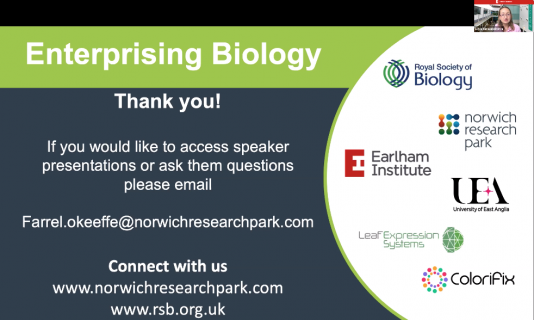
Dr Liliya Serazetdinova FRSB
Does Every Dog Have Its Day? The past, present and future impact of canines on human life
10 December 2019
Braving the Cambridge rush hour traffic, intrepid dog-loving members of the Royal Society Biology ventured out of the lure of their cosy abodes and into the depths of the Polar Museum for some captivating doggy discussions.
Dogs have long been considered ‘man’s best friend.’ Most agree that by 15,000 BC dogs were truly domesticated and were our companions long before farming, even. Since, dogs have played many roles throughout the ages: guards, hunters, pack animals, companions. We had three talks, about the past, present and future roles of canines in human life.
Our first speaker on the past role of dogs was Dr Peter Clarkson MBE of the Scott Polar Research Institute, talking about 50 years and thousands of miles of exploration and scientific research with the British Antarctic Survey and their beloved huskies. Have you contemplated that dog sledders are more likely to recognise the back of their dogs better than the front!
The speaker for the present role of dogs was Nicholas Burr from Guide Dogs talking about his journey with Guide Dogs. Did you know if you need a Guide Dog one of the questions you get asked is do you have a colour preference for your dog? It's because if you're a business person who wears a lot of suits, you might prefer a black dog so the hair shows up less on your clothes!
Our final speaker on the future role of dogs was Dr Will Pascoe from Medical Detection Dogs talking about using dogs to detect medical complications. You can smell a teaspoon of sugar in a cup of tea. A dog can smell a teaspoon of sugar in two Olympic swimming pools combined!
As well as our fascinating talks, we were given exclusive access to the Scott Polar Institute out of hours for a networking reception of light canapés and drinks, to continue our dog-related debate.
Natalie Lamb RSci MRSB
Biology Week: Walking with Alpacas Adventure
Thursday 10 October 2019
The East Anglia branch celebrated Biology Week 2019 in style with our visit to Misty Meadows, for a Walking with Alpacas Adventure.
Karen Hepworth-Lavery once went on an alpaca walk herself and fell in love with alpacas, with their distinctive personalities and gentle nature. Since then, Karen, and her husband John, were inspired to bring this experience to life for others, by buying 12 alpacas and setting up Misty Meadows Alpacas, a relatively small local operation dedicated to the welfare of these calming creatures.
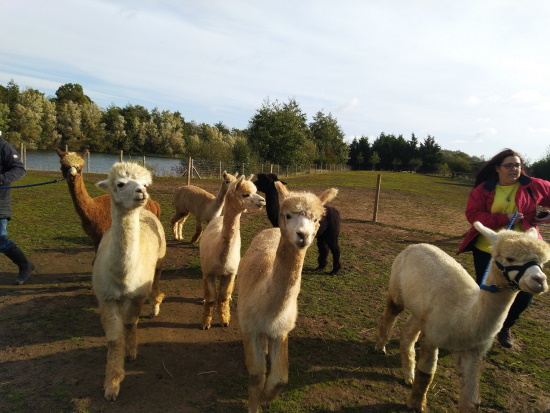
For the East Anglia branch of the RSB, we were highly grateful to come along on our gentle walk with these charming creatures in the scenic countryside location of Maxey. Our day started with getting to know how to care for alpacas and a bit more information about them. For instance, did you know that alpacas hum? They hum when curious, content, worried, bored, fearful, distressed or cautious!
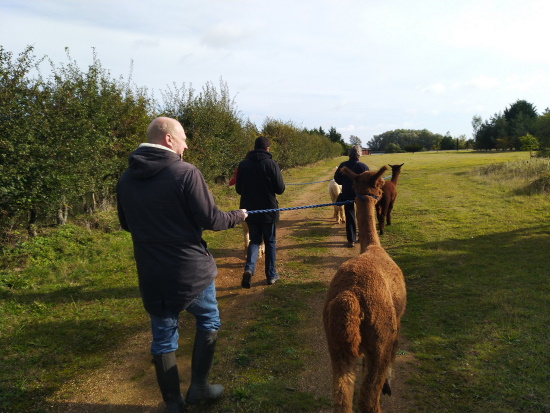
We then chose our own alpacas to walk, which was very difficult, especially as they have names such Pancake and Biscuit - you want to take them all! We then had the main event; the countryside walk while leading the alpaca on a rope, like walking a very large calm fluffy dog. The walk itself was a great experience and we enjoyed a wonderful hour of rambling with our new woolly friends. Finally, we got to hear a bit more about life with the alpacas and we had the opportunity to feed them their favourite, carrots, as a reward for our stroll with them that day.
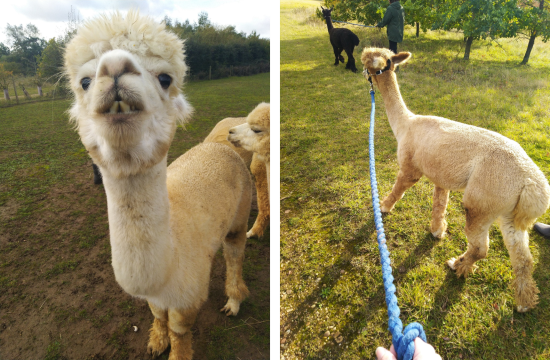
Overall, our alpaca walking trip was a unique experience loved by all present. Many of us wanted to take our alpacas home, but rest assured they are still safely at Misty Meadows, where they can be enjoyed by other visitors in future.
Natalie Lamb RSci MRSB
The RSB East Anglia branch AGM and Wandlebury walk
18 September 2019
The RSB East Anglia branch AGM was followed by a guided walk around key features of Wandlebury – a country park south of Cambridge. This proved to be an interesting mix of history and ecology.
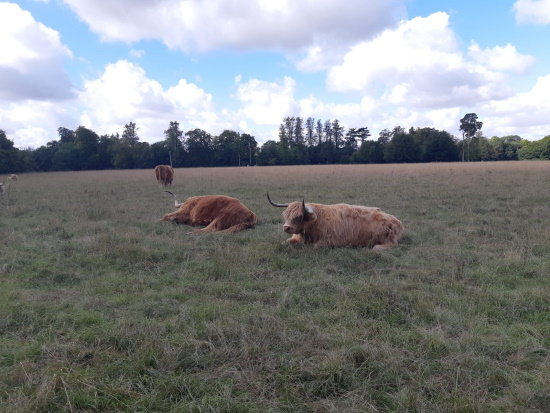
It included a description of the original estate and its gardens, photographs of previous inhabitants, the lost gardens, a mention of Godolphin the original Arab of racing stock buried beneath the stable archway and a description of the Iron Age fort and Roman roads. The group then walked across rare chalkland fields where key wildflowers were identified and their medicinal properties discussed including wild parsnip, marjaram, and other plants such as agrimony, wild scabious and Lady’s bedstraw. The latter was used not only as mattress stuffing but as a treatment for a variety of skin disorders. It was fascinating to witness how dispersal of wildflowers across the chalklands had been achieved due to grazing of a herd of highland cattle.
Dr Denise V. Dear MRSB
Suffolk Owl Sanctuary Visit
19 May 2019
On a Sunday morning in May, the East Anglia branch of the RSB had the pleasure of meeting Matt from the Suffolk Owl Sanctuary for a sold out guided tour. The sanctuary is a comprehensive facility for the care & rehabilitation of owls from the region, and the promotion of owl conservation throughout the UK and beyond.
Everyone agreed that Matt’s enthusiasm and passion as a falconer really came across in the talk, which focused on a selected number of the over 80 raptors that are housed at the sanctuary, making the day special. We then had some narrated flying demonstrations from native, exotic and American birds from the falconers Matt, Rufus and Rob. My particular favourite was Tura the Siberian Eagle Owl, with her beautiful white colouring, ability to silently swoop mere centimetres off the ground and lazy temperament.

The day was also interspersed with other animals, the playful meerkats standing to attention (although one did roll over hoping for a belly scratch), the shy but vitally important red squirrels and some highly mischievous ferrets.
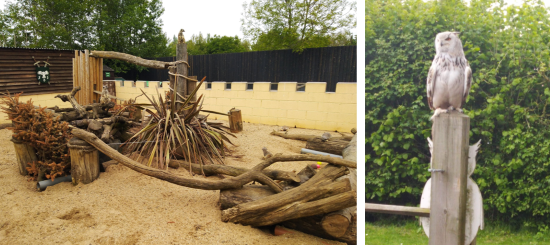
Overall, it was a great day out and we can’t thank the Suffolk Owl Sanctuary, and Matt in particular, enough, for our enjoyable visit. One member agreed, emailing to say “an interesting an enjoyable day at the Suffolk Owl Sanctuary. My wife and I enjoyed the tour and the flying displays very much.”
Natalie Lamb RSci MRSB
Guided Tour of the University of Cambridge Museum of Zoology
10 January 2019
From the moment you walk through the doors and you glance at the 21 metre long fin whale towering above you, you know you are in for a treat at The University of Cambridge Museum of Zoology. Members got to delve even deeper into the museum on our tour by Jack Ashby, museum manager. Jack gave us a fascinating insight into the exhibits, making them come to life and often highlighting the humorous backstories behind them.
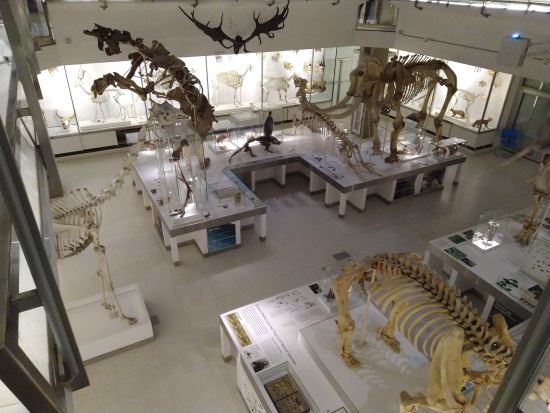
Particularly highlighted and explored were the new galleries, which were opened in the summer of 2018 after the museum’s renovation. The new galleries showcase the diversity of animal life, from marsupials to monkeys, mammoths to manatees.
The tour was the perfect opportunity to visit one of the largest and most important natural history collections in the UK and discover stories of extinction, survival, evolution and exploration. Thank you very much to Jack and everyone at the museum for our enjoyable visit.
Natalie Lamb RSci MRSB
An Interactive Tasting of Molecular Mixology
8 December 2018
The Cambridge Gin Laboratory really blew us away. We donned our lab coats, our lab assistant badges and got stuck in to an interactive tasting menu of molecular mixology.
Dr Jon Winter-Holt and Dr Emily Hallinan immersed us in the science behind gin and delivered an engaging, entertaining and informative afternoon. We had the chance to make our cocktails, blending them to our own tastes, while learning about the different flavours and where they originate from.
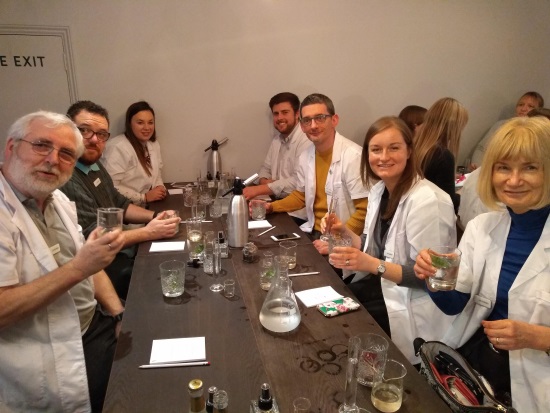
As one member said, “the mix of theory, practice and gin was just right…” It proved to be a completely different Christmas event. Not only did we all learn something new but it was a great opportunity to meet other members. I would like to thank the Cambridge Gin Laboratory for this unique experience.
Natalie Lamb RSci MRSB
AGM, Lunch and Guided Tour of Trumpington Meadows
4 August 2018
After flexing our minds during our AGM, it was time for our brains to get a well-earned break while we flexed our legs instead. Rebecca Green, community engagement officer with The Wildlife Trust gave us a highly enjoyable tour around Trumpington Meadows Country Park and Nature Reserve. We learned all about the regular management of the area by The Wildlife Trust, including the grazing and hay cutting, all done to benefit the local wildlife.
Of particular interest to members, some of which used to work in the area, was the rich history of the area. Trumpington Meadows has been occupied for centuries, including being a home to Roman and Saxon settlements, a famous plant-breeding facility, a prisoner-of-war camp, coprolite pits and arable fields.
Although it was a swelteringly hot day, our tour followed the planned route of the north section of the reserve, through Byron’s Pool, along the river, around the pond and back through the wildflower meadows. A very enjoyable tour and we much appreciated Becky for making it so.
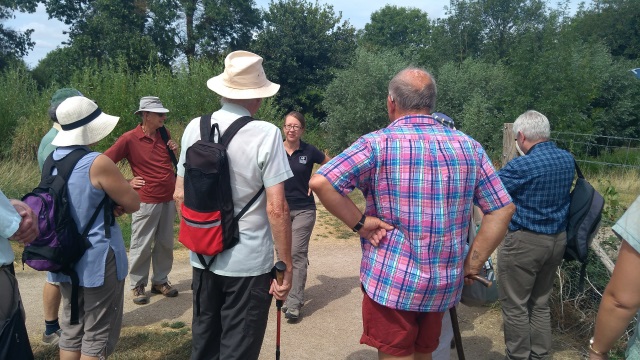
Natalie Lamb RSci MRSB
Guided Tour of Blakeney Point
7th July 18
The East Anglia Branch chose the perfect day for our excursion with Beans Boats to Blakeney Point. As the boat progressed through Morston Creek and out into Blakeney Harbour, the splashing of the water was a refreshing break from the heat. We were greeted with the view of Common Seals and Grey Seals basking in the sun on the sandbanks at the far end of Blakeney Point. At one point, our boat got a little too close to the shore and we were soon being told off by a particularly territorial Tern, diving at the boat and giving us a warning. Blakeney Point is now an international breeding ground for many migrant birds and Terns, mainly Common, Sandwich and Little Terns and, quite often, also Arctic Terns, are popular summer visitors.
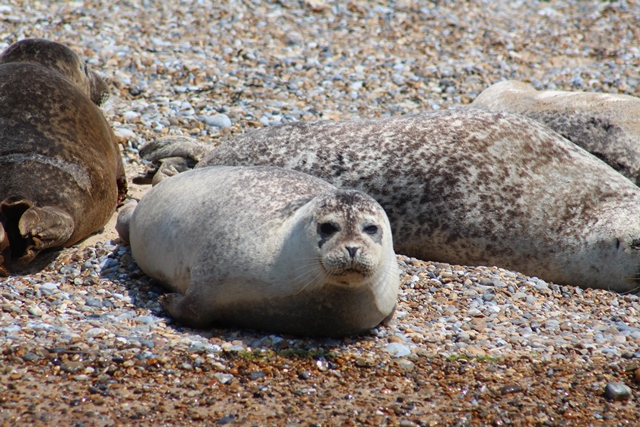
After seeing the seals, our boat landed on Blakeney Point itself, for a 1h tour by The National Trust. We walked through the dunes to a sandy beach, stopping every so often to learn about the history, conservation and specialist species which live on the shingle spit. Overall, everyone had a thoroughly enjoyable day. There was fun, there was science but hopefully there wasn’t too much sunburn!
Natalie Lamb MRSB
Adult Pond Dipping
12 May 2018
Vicky Chambers’ enthusiasm and passion for wetland habitats really came through during our hour long pond dipping session at Ferry Meadows. We really appreciated the work of the Nene Park Trust and learnt a lot about freshwater life in our local area. Not only did we find it a really enjoyable way to spend a Saturday morning, but the identification we did will help fit into a larger ecological study.
Afterwards, we had time to network with cake and coffee in the café, before doing a bit more independent exploration of Ferry Meadows. One member specified that the event could have been improved with “More time! We could use another hour”. Overall, we all had a very enjoyable time and would love to repeat the experience. Thank you to Vicky.
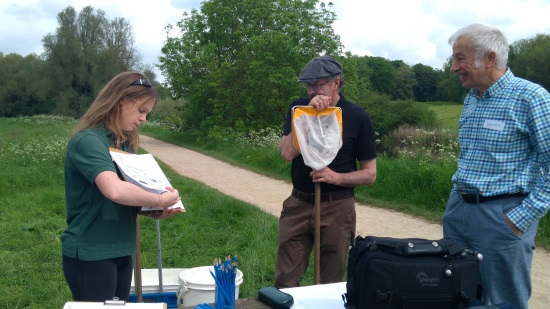
Natalie Lamb MRSB
Escape from Dr Paulitious's Lab
15 March 2018
Hour Escape Rooms Peterborough introduced us to an interactive group mystery game, where we had to find hidden clues and solve puzzles to exit the "escape room" – in this case a lab. The theme was to travel back in time to Edinburgh to 1888 to find a vial of an original strain of the plague to save the current world (the year 3031) from a new strain of the Bubonic plague that had mutated from the original strain and is resistant to all medicines. It made for a great networking and team building activity! Our team, The RSB Doctors, made it out before the 60 minute timer was up – very well done team!
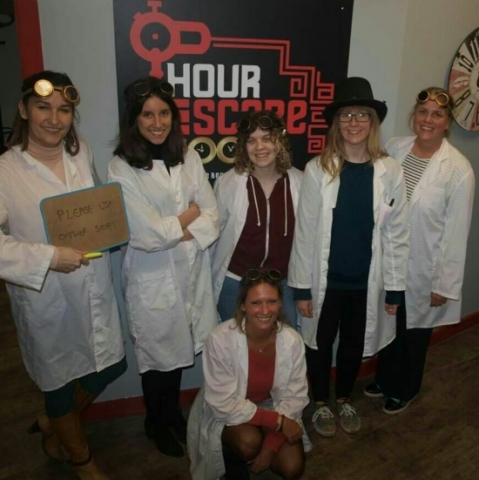
Natalie Lamb MRSB
AGM and Student Poster Competition
16 September 2017
Did you know the turquoise killfish N. furzeri has a lifespan of only six months? Or if the proportion of milk powder in chicken feed rises above 16%, it can result in reduced growth? Or that the UK spends £36 million every year on chemicals for the treatment of drinking water? These are just a few of the facts that East Anglia RSB members had the opportunity to learn at the East Anglia AGM and Student Poster Competition.
The day started like any other Saturday, with tea, coffee and plenty of biscuits in a cosy chair on a rainy September morning, except it was at The University of East Anglia. The members went into a meeting room for the AGM and we had an in-depth discussion, particularly focused on potential events and the use of social media to aid RSB communications.
After much talk and a well-deserved lunch, we learned all about the research passionate students are completing within the local area. The way the posters were able to explain complex science in a way non-experts can understand was very impressive.
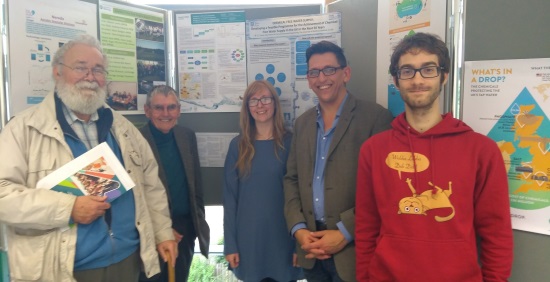
A massive congratulations to Michele Sanguanini, PhD researcher from the University of Cambridge for winning 'The Infohackit Prize for the Best Research Communicator' and Iman Ibrahim, PhD Researcher from Imperial College London for winning 'Best Technical Knowledge'. I was delighted to win 'Most Innovative Poster' for my PhD research based at the University of Sheffield.
Overall it was a great event with plenty of opportunities for networking and learning all about a really variety of different research. Thank you very much to the attendees, the students, The University of East Anglia and Infohackit, the prize sponsor.
Natalie Lamb RSci MRSB
AGM at Chilford Hall
4 September 2016
The East Anglia branch came together on a bright September day for the AGM.The location was lovely - Chilford Hall and its gardens were an excellent location to enjoy the meeting, filled with interesting architecture and many a sculpture. After an active AGM discussion, a scrumptious afternoon tea was well deserved.
We then took a tour of the vinery and winery. The tour was incredibly detailed, covering the entire wine making process from the management of the vines, the pruning and picking of the grapes, through to the processing, fermentation, blending and bottling. The tour guide, Ged Bell, spends his time working on all aspects of the process and really brought the whole journey to life.
The, finally, the bit everyone had been waiting for - the wine tasting! We tried six different wines, all with different flavours and bouquets. The tour guide explained what the wines were, how they were made and how their tastes varied. It really made you appreciate the wine, once you realised how much effort had gone into the whole production. When the last drop had been drunk, it was time to leave a successful and a fun AGM.
Natalie Lamb MRSB, Chair of the East Anglia branch
Visit to a Honey Bee Apiary
4 June 2016
Honey bees are so important to the environment, yet never have they faced so many threats to their survival. East Anglia members visited the Huntingdonshire Beekeepers Association at their apiary in Hinchingbrooke Country Park to learn more about these fascinating creatures and to get hands on experience of working hives.
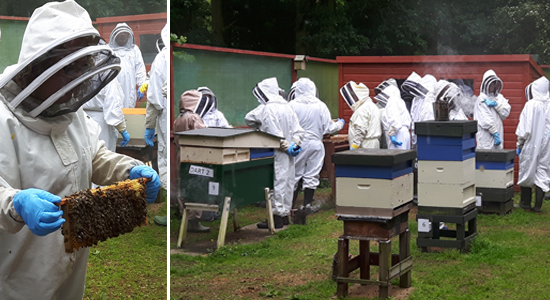
Our visit began with a short talk about the apiary, the types of hives, and what we might see. Despite a few reservations, every member put on a bee suit and went into the apiary to meet the bees. We saw how the health of a colony is checked, and found eggs, larvae, and the queen in most of the 16 hives. Members got hands on – feeling the weight of the frames, seeing the incredible activity, and hearing the sounds of the hive – a rare opportunity for which one member had driven over 90 miles!
During the session, the beekeepers discovered a new queen, and we saw her being marked. After a couple of hours in the apiary, one of the colonies became agitated and we were told the bees may be deciding to swarm. It was time for us to return to the bee free gallery for tea and cake, and a chat with the beekeepers. After the opportunity to see what activity bees are doing when not visiting our gardens, we were left with a new respect for the hard working honey bee.
Helen Seaby MRSB
British American Tobacco Tour
17 February 2016
British American Tobacco (BAT) opened its doors to 20 members for a behind the scenes look at their research and development laboratories in Cambridge. Special thanks to BAT staff that helped during the visit; David Wrycraft, Louise Jones, Luke Richards, Susie Davenport, Kirsty Forsyth, and Deidre Wylie, who fielded questions and joined in discussions throughout the tour.
BAT Cambridge has recently undergone a program of lab refurbishment, which we were able to see. We saw what BAT is doing in terms of tobacco harm reduction, including research into how to reduce the concentrations of toxicants in cured tobacco. This may be done either with traditional breeding or more contemporary molecular techniques, using state of the art biochemical systems to analyse their results.
Small interactive and informative talks were given at each area by staff members, and we were able to see how to cultivate an entire plant from just a leaf disc.
After lunch there was an opportunity to network with the other members of staff at BAT we learnt a great deal about what they are doing to make smoking less harmful.
Mr Adam Rodgers MRSB
The Polar Museum, Cambridge
20 January 2016
Naomi Chapman, education and outreach officer of The Polar Museum and Scott Polar Research Institute, conducted a very insightful tour for 19 members from across East Anglia and Beds, Herts & Essex.
The geologist Frank Debenham formed ideas for the establishment of a polar research centre, having been trapped in Antarctic blizzards in 1912. In 1920 he established the Scott Polar Institute, and the museum was completed in 1934. It remains a repository for over 10,000 polar artefacts, with a rolling exhibition and other artefacts kept in deep freeze vaults.
Of course there are many exhibits belonging to the ill-fated Scott exhibition of 1912, including personal letters – it was difficult not to be moved by these. Scott heavily documented his expedition which has proved of immense historical value.
The museum has many items from the polar regions from old to new such as a beautifully beaded anorak from West Greenland and the much travelled telescope from HMS Discovery (British Artic Expedition, 1875-76) and Scott’s ship Discovery (British Antarctic Expedition, 1901-04), which was taken into space on the shuttle Discovery in 1984.
Having visited this museum many times before, one thing I learnt from the guided tour was that penguins are hidden in the paintings of the Artic and Antarctica on the ceilings of the Memorial Hall. The paintings were completed by Macdonald Gill in situ in 1934. The penguins are not painted in, so are challenging to see, but if you want a tip look at the Astrolabe Peninsula.
There is a repeat unguided visit on the 1st October 2016.
Mary Parsons AMRSB
The Importance of Biology in the Sewage Treatment Works Process
16 January 2016
The East Anglia members had a surprising treat when visiting Cambridge Sewage Treatment Works on a frosty Saturday morning in January.
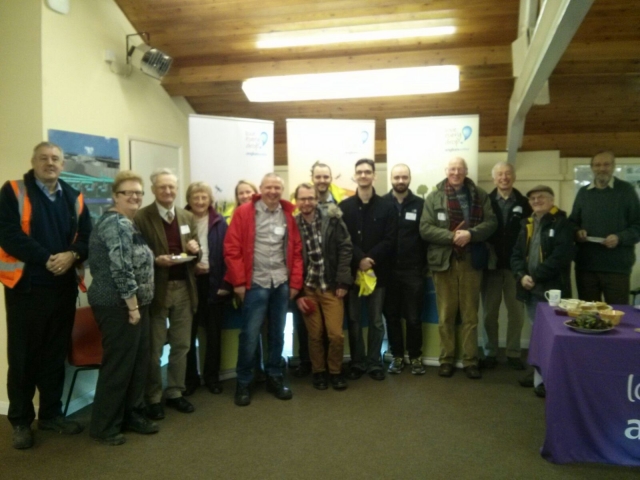
Ceri Williams, Cambridge Water recycling manager, gave an incredibly informative tour of the works. You could see the works while it was operational, from the not-too-pleasant influent right through to good-quality fertiliser. And we were so close to the processes that you could almost touch it (not that you would want to, of course!). Regardless, the quality of the tour was exceptional, with Ceri showing true patience while answering the many questions which we had been inspired to ask.
There were also members of the Anglian Water laboratory team, who were able to identify the microorganisms in different sewage samples, shown by videos of microscopy. It was interesting to get a more first-hand perspective of these organisms, from the people who actually try to identify them on a day-to-day basis. They did a superb job, especially because they were put on the spot with the questioning.
Marcia Davies, community education team manager, did an excellent job of organising the day with Natalie Lamb, Chair of RSB East Anglia branch and assistant operational scientist at Anglian Water. Marcia also provided us with some brilliant food and a much-needed cup of tea after the tour (and after a good hand-washing).
Mr Andrew Buchan Notman CBiol MRSB said:
"Thank you for the visit yesterday. It was very interesting and enjoyable... Please also thank Ceri Williams and the staff for explaining all the details and answering all the many questions, along with the refreshments. It completed the visit."
Natalie Lamb RSci AMRSB
Contemporary Research in...
24 April 2014
The "Contemporary Research in..." series, which involves young scientists at PhD or Post-Doc level at local universities and research institutes talking about their research, began in 2013. After successful evening events in biochemistry and pathology last year, our spring 2014 talk moved to plant science, with all our speakers coming from the University of Cambridge.
Sarah Covshoff talked about her work to increase the photosynthetic efficiency of rice. Her research is funded by the C4 Rice Consortium, which is supported by the International Rice Research Institute and the Bill and Melinda Gates Foundation.
Of the two different types of photosynthetic plant – C3 and C4 – C4 plants have a mechanism that enhances yield by maximising CO2 capture from the air. Sarah and the rest of the consortium aims to introduce a gene cluster of 20+ genes derived from C4 plants into the rice genome, increasing grain yield while decreasing water and nitrate demands. This project has huge potential in enhancing food security in parts of the world reliant on rice as the staple crop.
Johan Kudahl explained how modelling biological systems could help reduce the production costs of biodiesel from algae, currently six times more expensive than equivalent fuels. Modelling biological systems can show us how we might manipulate enzyme production and use different media to enhance growth and productivity. With this research, biofuels may be an increasing part of the solution to energy demands.
Yoan Coudert's work looks at the genetic mechanisms which allowed land plants to develop their form, how a single-stemmed ancestor like a moss with determinate growth evolved to form plants with indeterminate growth and a branched structure. We explored the question: can we create extinct early land plants? The simple answer was no. In the same way as Jurassic Park was a work of fiction to recreate dinosaurs, 450 million old DNA can't be used to recreate the first land plants.
Paul Grant explained how he uses E. coli to study synthetic pattern-forming genetic circuits. Understanding pattern-formation in these simple systems may throw light on mechanisms operating in higher organisms. We look forward to our next talk in the series.
Amanda Burton
Visit to Bluegnome – Illumina
14 October 2013
Twenty five East Anglia branch members were privileged to visit Bluegnome Ltd, Cambridge, one of the UK's fastest growing biotech companies. Along with its holding company Illumina, it is at the frontline in IVF technology and rapid DNA analysis. The state of the art laboratories demonstrated the advanced automation in this industry.
Professor Alan H Handyside, head of preimplantation genetics at Bluegnome and the University of Leeds, outlined the IVF timeline from pioneers Edwards and Steptoe and the first IVF live birth in 1978 through to the current role of Preimplantation Genetic Diagnosis (PGD). This contributes to 5000 (1%) of UK births each year. This screening method is used to monitor preimplantation embryo development.
Array CGH (Comparative genomic hybridisation) is used to detect abnormalities of chromosome number (aneuploidy), which increases exponentially in women in their late 30s and early 40s. This diagnostic test analyses the chromosome composition of oocyte polar bodies or single embryo cells and can detect aneuploidy for any of the 22 pairs of autosomes and the sex chromosomes. Dr Marc Botcherby described how Array CGH testing at blastocyst stage is used in both prenatal and post natal testing.
Dr Russell Grocock reminded us that DNA is one of the world's longest molecules. We each have enough DNA to stretch to the sun and back more than 300 times! Russell described the Next Generation Sequencing (NGS) protocol to prepare a DNA sample for synthesis and sequencing.
Dr Mark Ross addressed the wide-ranging applications of NGS in forensics, agronomy, infectious disease outbreaks, antibiotic resistance, and cancer research and diagnosis, possibly because NGS produces large amounts of sequence data from many individuals, cheaply and quickly.
Bluegnome's hospitality and the speakers' generosity with their professional time were most appreciated.
Krystyna N Zielinski-Smith CBiol MSB
Lynford Arboretum fungus foray
6 October 2012
"You can eat all fungi...at least once". This popular saying amongst field mycologists was our first piece of advice from guide, Dr Tony Leech, the fungus specialist for the Norfolk and Norwich Naturalists Society and founder of the Norfolk Fungus Study Group. On his instruction we dispersed in all directions and within minutes, handfuls of specimens were being thrust in Tony's direction.
With so many specimens to be found, it took over an hour just to get out of the car park. Once into the arboretum proper, with its closer cropped turf and different woodland flora, a whole new selection of species came to light.
Amongst our finds, were shaggy ink cap, amethyst deceiver, honey fungus, false chanterelle, wood blewit, russulas, the occasional cep and the rather beautiful coral fungus. Not all species are readily identified in the field, so a number of our finds went straight into the basket and back to the lab for closer scrutiny.
Tony commented that he'd never had a group quite like ours, who stopped and listened to his every pronouncement, photographed the specimens and took detailed notes – perhaps not too surprising though, for members of the Society of Biology. Having overrun our allotted time we had only explored around 300 metres into the main arboretum; more for another day's exploration.
Ian Black CBiol MSB
Lakenheath Fen
16 June 2012
In 1995 Lakenheath Fen was a 740 hectare site of farmland, growing carrots between stands of poplar. Today it's an RSPB reserve of rich biodiversity, home to golden oriole, many pairs of nesting marsh harrier, bearded tit, bittern, reed warbler, reed bunting and the recent colonising crane.
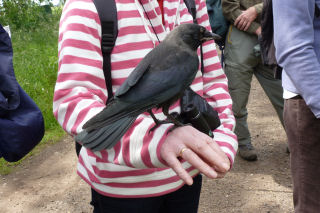 David White, information officer for Lakenheath, led a fascinating walk. Before setting off David warn us about "Jack", a young jackdaw, the self-appointed gatekeeper who welcomes visitors. Sure enough after 50 metres there was Jack, soon hopping on willing hands, shoulders and heads. We hadn't anticipated being quite so close to nature!
David White, information officer for Lakenheath, led a fascinating walk. Before setting off David warn us about "Jack", a young jackdaw, the self-appointed gatekeeper who welcomes visitors. Sure enough after 50 metres there was Jack, soon hopping on willing hands, shoulders and heads. We hadn't anticipated being quite so close to nature!
Marsh harriers were ever present, hunting over the extensive reed beds after another successful breeding season. The reed beds are a tribute to the back-breaking work by volunteers who planted 250,000 reeds by hand. The day was a bit windy so no bearded tits flying but plenty of reed and sedge warblers singing and a cuckoo telling us that the warblers better get ready for an unexpectedly large chick.
During our walk we gained a full appreciation of the conservation efforts shaping the reserve now and into the future. Paramount is to control water. A system of sluices control water levels and over 4km of channels were added to the existing ditch network to move water around the site.
In 17 years Lakenheath has become a magnet for birders and nature enthusiasts alike. A visit is highly recommended.



